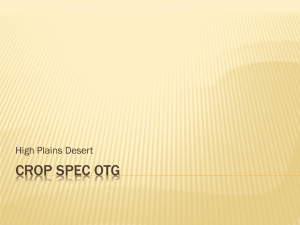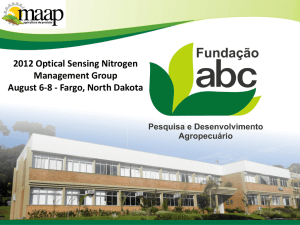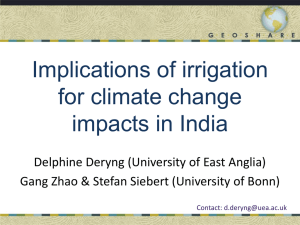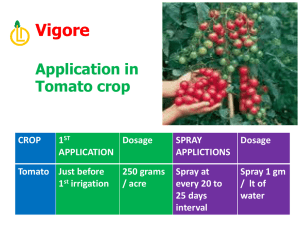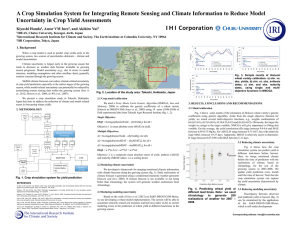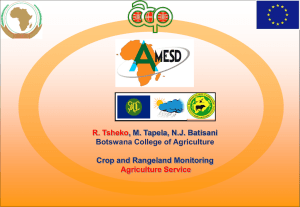Crop_Condition_Monitoring_Review
advertisement
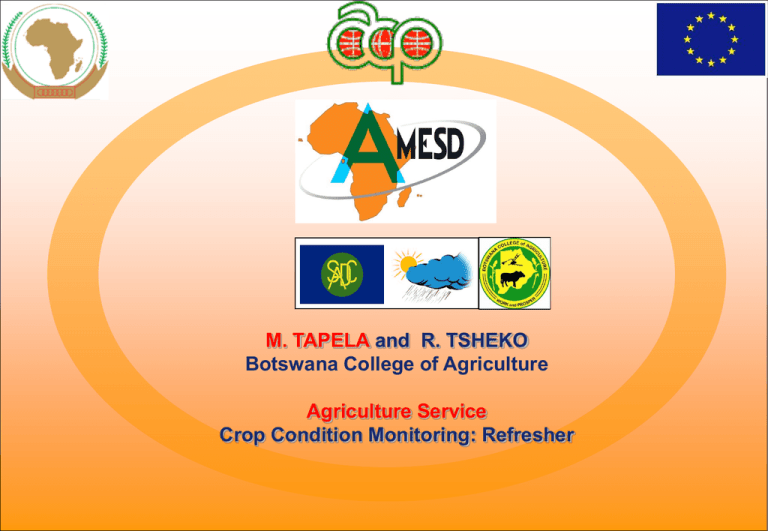
M. TAPELA and R. TSHEKO Botswana College of Agriculture Agriculture Service Crop Condition Monitoring: Refresher Agenda SADC THEMA Services PRESENTATION FORMAT 1. 2. 3. 4. 5. Introduction Overview of Agricultural Applications Spectral Response of Vegetation Vegetation Indices Rainfall and Water Indices 1. Introduction: What can you see ? Field A Field B 1. Introduction: What can you see ? © CCRS Crop Condition Monitoring A Crop Condition Monitoring B Crop Monitoring help farmers to understand the health of the crop, extent of infestation or stress damage, or potential yield and soil conditions. 1. Introduction: What can you see ? Commodity brokers are also very interested in how well farms are producing, as yield (both quantity and quality) estimates for all commodity price and worldwide trading. Governments are interested in order to prepare for possible food shortages. Regional economic bodies such as SADC, ECOWAS and Development Partners need crop monitoring for Famine Early Warning Systems (FEWS) 1. Introduction: What can you see ? FEWSNET Estimated Food Security Outlook – 4Q 2011 2) Overview of Agricultural Monitoring Remote Sensing Applications and Products: About 70% of the Earth’s land surface is covered with vegetation. Remote sensing is used for agriculture, forests, rangelands, wetlands and urban vegetation assessment. There are generally three (3) areas in which remote sensing products are used in agriculture, namely: o crop type classification, o crop condition monitoring or assessment, o crop yield estimation (prediction) 2) Overview of Agricultural Monitoring Crop type classification and crop area estimation: Based on the premise that a crop can be identified based on its spectral signature. Requires knowledge of the developmental stages of each crop in the area to be investigated. A crop calendar is used to list expected. developmental status and appearance of each crop in an area throughout the growing season. Crop area (crop masks) is estimated/measured from land use maps derived from high spatial resolution imagery. © CCRS 2) Overview of Agricultural Monitoring Crop condition assessment : Information on crop condition can be obtained from satellite imagery to assess; o Crop disease o Insect/Pest damage o Crop stress o Disaster damage (flood, drought, hail storms, fire) Depending on the observed problems, remedial measures could be put in place such as replanting, herbicides/fertilizer treatment, and drainage. © CCRS 2) Overview of Agricultural Monitoring Crop yield estimation: Achieved by determining the area of each crop type and estimating the yield per unit area of each crop Crop yield depends on several factors such as soil moisture, soil fertility, air and soil temperature Yield can also be affected by disease, insects’ infestation, physical damage Field inspection of sample sites are used to; o validate the satellite observations o develop correlations between spectral signatures and crop yield 2) Overview of Agricultural Monitoring Crop yield prediction : Historical data on crop yield from individual fields as well as satellite information can be used for crop yield prediction Meteorological satellites provide both climatic and meteorological data that is required for yield prediction Satellite information can be used to determine how in a certain year yield deviates from the normal trend Monitoring biomass over time can provide important information about the likelihood of good or poor harvest as well as the stability of the natural ecosystem 2) Overview of Agricultural Monitoring Agriculture Products – SADC THEMA Agricultural Service Products Agricultural Baseline Products 1 AP01: Agriculture Mask 2 AP02: Crop Statistics Map 3 AP03: Crop Specific Maps Agricultural Products from Meteorological Ground Measurements 4 AP04: Current Conditions Rainfall Map 5 AP05: Current Condition Cumulate Rainfall Map 6 AP06: Current Conditions - Air Temperature Map 7 AP07: Graph of Rainfall Events in the Current Season 8 AP08: Map of current Rainfall compared with the LTA, Max and Min values (mm) 9 AP09: Map of current Rainfall compared with the LTA, Max and Min values (%) 10 11 12 AP10: Map of current Cumulate Rainfall compared with the LTA, Max and Min values (mm) AP11: Map of current Cumulate Rainfall compared with the LTA, Max and Min values (%) AP12: Graph of Cumulate Rainfall of the current season compared to the LTA, LTMax, LTMin 13 AP13: Map of current Air Temperature compared with the LTA, Max and Min values (oC) Agricultural Products from Remote Sensing 14 AP14: Current Rainfall Estimates Map 15 AP15: Rainfall Estimates Compared with average [difference] 16 AP16: Rainfall Estimates Compared with average [%] 17 AP17: Cumulate Rainfall Map 18 AP18: Cumulate Rainfall Map compared with Average (% Anomaly) 2) Overview of Agricultural Monitoring Agriculture Products – SADC THEMA 19 AP19: Vegetation Index Map 20 AP20: Vegetation Index Compared with average [difference] 21 AP21: Vegetation Index Compared with average [%] 22 AP22: Crop / Vegetation performance Graphs 23 AP23: Current Water Requirements Satisfaction Index (WRSI) Map 24 AP24: WRSI Anomaly maps 25 AP25: Onset of Rains Maps 26 AP26: Onset of rains anomaly maps 27 AP27: Soil Moisture Index Maps 28 AP28: Current dry matter productivity map 29 AP29: Cumulate dry matter productivity map 30 AP30: Cumulate dry matter productivity graphs 31 AP31: Cumulate dry matter productivity comparison with average maps (%) 3) Spectral Response of Vegetation Definition of Remote Sensing : Remote sensing may be defined as the art, science, and use of technology to observe an object, area or phenomena and obtain information about it whilst not in contact with it. The term embraces a number of observation or sensor techniques ranging from; o photography, o multispectral, o thermal o hyperspectral sensing Satellite-based observation methods have gained wide application compared to aerial photography 3) Spectral Response of Vegetation Spectral Response of vegetation: Green plants have unique spectral reflectance which is influenced by the state, structure and composition of the plant. Healthy plants will reflect more radiation in the near infrared region of the spectrum. 3) Spectral Response of Vegetation Radiation - Leave Interactions : Chlorophyll strongly absorbs radiation in the red and blue wavelengths but reflects green wavelengths In autumn, there is less chlorophyll in the leaves, so there is less absorption and proportionately more reflection of the red wavelengths, making the leaves appear red or yellow (yellow is combination of red and green wavelengths) 3) Spectral Response of Vegetation Radiation - Leave Interactions : 3) Spectral Response of Vegetation Radiation - Water Interactions : Water typically looks blue or blue-green due to stronger reflectance at these shorter wavelengths, and darker if viewed at red or near infrared wavelengths. Suspended sediment present in the upper layers of the water body, then this will allow better reflectivity and a brighter appearance of the water. 3) Spectral Response of Vegetation Spectral Signatures: Reflectance of vegetation and water at different wavelengths can be used to identify and separate different materials or objects using multi-spectral data 3) Spectral Response of Vegetation Spectral Signatures: A combination of wavelengths (more than one) may be used to make the distinction in what we call multi-spectral remote sensing 3) Spectral Response of Vegetation Spectral Signatures: Spectral Reflectance may also be used to distinguish between different vegetation types (Crop Masks) 4) Vegetation Indices VEGETATION PRODUCTS 4) Vegetation Indices NDVI : NDVI is a dimensionless index that is indicative for vegetation density and is calculated by comparing the visible and near-infrared sunlight reflected by the surface (reflectance). NDVI = (NIR — VIS)/(NIR + VIS) where NIR is the near-infrared reflectance and VIS is the reflectance of visible light. 4) Vegetation Indices NDVI : The product is distributed as digital numbers (DN). To decode the values to the real numbers the following formular is used: NDVI (real values) = (DN * Sc) + Off Sc: 0.004 Off: -0.1 Moderate values (around 0.2 and 0.3) correspond to shrub and grasslands. 4) Vegetation Indices NDVI : NDVI values range between -1 and +1, with dense vegetation and healthy having higher values (e.g., 0.4 - 0.7), and lightly vegetated regions having lower values (e.g., 0.1 0.2). Single season NDVI NDVI Anomaly - Tanzania 4) Vegetation Indices NDVI : Over the course of a growing season, we first see a steady increase in the NDVI values as the young, green crops grow (the growth makes the surface appear more and more green, which is reflected by the NDVI). This increase reaches a maximum value just before it drops suddenly at harvest time (or when the plants die naturally), which can easily be explained by the harvesting of the healthy, green plants, which makes the surface appear less green. 4) Vegetation Indices NDVI : Used for crop and agricultural monitoring and early warning of failing growing seasons. Typical Crop Phenological Stages Vegetative Reproductive Ripening 45 days 35 days 30 days 4) Vegetation Indices NDVI : 4) Vegetation Indices NDVI : NDVI time series for Pandamatenga Region in Botswana 1 0.9 0.8 min max mean 2STD ndvi-2010 0.7 NDVI values 0.6 0.5 0.4 0.3 0.2 0.1 0 0 5 10 15 20 Dekad 25 30 35 40 4) Vegetation Indices NDVI : % Anomaly Map = (Current NDVI – Average NDVI) x 100 / (Average NDVI) Other uses include: Monitoring of long-term vegetation changes and climate change models, seasonality studies Assessment of desertification events Indicator and alert function for drought events Create land cover maps 4) Vegetation Indices Corine NDVI (Crop Specific) CNDVI: CORINE NDVI (CNDVI) is a landcover weighted NDVI. The CNDVI method extracts NDVI profiles and averages them on crop areas (such as maize) by region or administrative zones to provide an indicator of crop status and yield. Extraction average of red pixels (cropped areas) within the zone of interest (blue polygon) from the raster data for the current season and the long-term averages for the same periods 4) Vegetation Indices Corine NDVI (Crop Specific) CNDVI: NDVI images are converted to represent an agricultural production region; this is achieved by computing regional NDVI means and weighting the values according to each pixels’s area occupied by the land cover type of interest (a specific crop such as maize). Nr ,i CNDVI r ,c,t W r ,c,t ,i .NDVI i i 4) Vegetation Indices Dry Matter Productivity (DMP): DMP, or Dry Matter Productivity, is an indication of the dry matter biomass increase (growth rate) expressed in kg/dry matter/ha/day. The increase in dry matter biomass on a daily basis (subscript 1) can be formulated as: DMP1 = R1 · 0.48 · fAPAR1 · ε(T1) · 10000 Where R1 (J/m²/day) is the incoming short wave radiation of the sun (200-3000 nm), which is composed on the average for 48% of PAR (Photosyntheticly Active Radiation: 400-700nm) fAPAR1[-] is the PAR-fraction absorbed by the green vegetation. 4) Vegetation Indices Dry Matter Productivity (DMP): DMP, or Dry Matter Productivity, is an indication of the dry matter biomass increase (growth rate) expressed in kg/dry matter/ha/day. The increase in dry matter biomass on a daily basis (subscript 1) can be formulated as: DMP1 = R1 · 0.48 · fAPAR1 · ε(T1) · 10000 Where R1[J/m²/day] is the incoming short wave radiation of the sun (200-3000 nm), which is composed on the average for 48% of PAR (Photosyntheticly Active Radiation: 400-700nm) fAPAR1[-] is the PAR-fraction absorbed by the green vegetation. ε(T1) [kgDM/JPAR] accounts for the conversion of this absorbed energy into biomass 4) Vegetation Indices Dry Matter Productivity (DMP): DMP, or Dry Matter Productivity, is an indication of the dry matter biomass increase (growth rate) expressed in kg/DM/ha/day 5) Rainfall and Water Indices RAINFALL and SOIL MOISTURE PRODUCTS 5) Rainfall and Water Indices Water Requirement Satisfaction Index (WRSI): Crop Water Requirement Satisfaction Index is the ratio of the actual evapotranspiration (AET) to the maximum evapotranspiration (MET) for a given dekad. WRSI is an indicator of crop performance based on the availability of water to the crop during a growing season. This map portrays WRSI values for a particular crop from the start of the growing season until this time period. 5) Rainfall and Water Indices This product is useful in identifying areas with crop failure. 5) Rainfall and Water Indices Water Requirement Satisfaction Index (WRSI): FAO field studies showed that crops with WRSI values; less than 50% had crop failure 80 indicates average crop performance 100 ("no deficit“) corresponds to the absence of yield reduction related to water deficit 5) Rainfall and Water Indices Soil Moisture Index (SWI): Soil Moisture Index (SMI) is the ability of the soil to supply moisture to the plant. SWI = SW/WHC x 100% SW = SWi-1 + PPTi - AETi WHC = Water Holding Capacity SW = Soil water content PPT = Precipitation, i = the time step index. The END Thank You. REFERENCES BROWN E. M.(2008) FAMINE EARLY WARNING SYSTEMS AND REMOTE SENSING DATA. SPRINGER-VERLAG BERLIN HEIDELBERG CANADA CENTRE FOR REMOTE SENSING. 2010. FUNDAMENTALS OF REMOTE SENSING LILLESAND, T.M. AND KIEFER, R.W. (1994) REMOTE SENSING AND IMAGE INTERPRETATION. JOHN WILEY AND SONS INC., NEW YORK REMOTE SENSING TUTORIAL. HTTP://RST.GSFC.NASA.GOV
